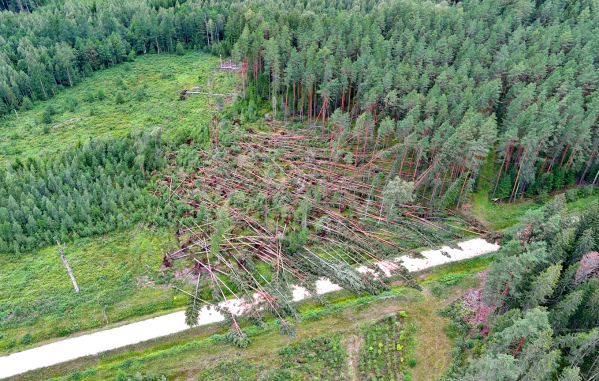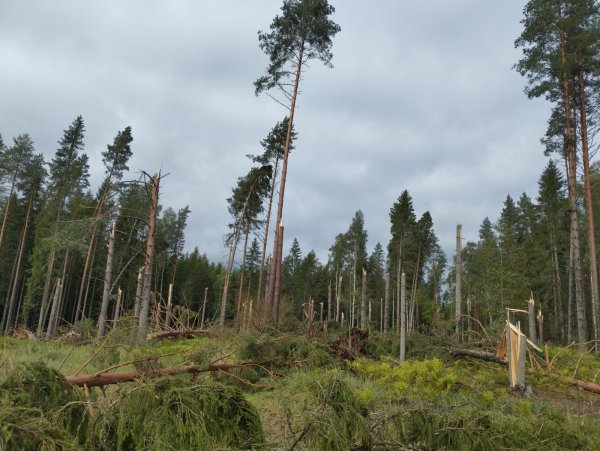Impact of Climate Change and Wind on Forestry
The damage caused by the August storms this year in the territory managed by JSC “Latvia's State Forests” (LVM) reached more than 100 thousand cubic metres of felled or broken wood, whereas in the popular tourist resort in Zemgale – the LVM Nature Park in Tērvete – thousands of trees were broken and felled, thus changing the usual nature of the park landscape.
LVM is actively working to adapt its economic activity to the challenges brought by climate change: methods of detecting disturbances caused by nature and digital tools are developed for the operative detection and assessment of potential damage risks, economic measures are implemented for operative damage prevention and economic activity methods and techniques are improved, employees and cooperation partners are trained, raising the understanding of the risks and opportunities caused by climate change. LVM also carries out various research and studies in cooperation with Latvian scientific institutions.
The main risk – damaged caused by wind
As scientists attest, wind is the most common natural disturbance in European forests, and the proportion of its damaged stands has tended to increase in recent decades, causing significant socioeconomic and ecological losses.
The financial losses caused by storms are expected to increase not only due to changes in their frequency, but also in the type of damage: higher wind speeds increase the probability of tree breakage, reducing the proportion of the most valuable varieties that could otherwise be produced from felled trees through sanitary felling. Although birch stands are considered more resistant to wind damage as compared to, for example, spruce or aspen stands, they too have seen an increase in damage, partly due to storm damage while the trees are in leaf.
Primary and secondary breakage of trees
When wind acts on the tree trunk, significant structural damage to the wood occurs – compression of the vascular tissue or tracheids (primary breakage), which is also formed under the influence of a smaller wind load than is necessary for its toppling or breaking (secondary breakage).
Under the influence of primary breakage damage, the tree remains viable, but its durability and vitality decrease. Primary breakage in the long term contributes to the death of the tree under the influence of various adverse conditions, such as wind stress, drought, the spread of pests or diseases. Primary breakage damage can also be reversible, as studies have observed restoration of the mechanical stability of trees; however, this process is slow and during it the weakened tree is exposed to regular wind and other damage risk factors for a long time. This, in turn, increases the recurrence of structural damage to the wood and thus increases the risk of breaking or falling even under the influence of less heavy wind.
Resistance of forest stands to wind
The parameters of individual trees, as well as taxonomy indicators of the entire forest stand, such as density, average height and diameter, species composition and maintenance regime, characterize the resistance of the forest stand to damage caused by wind.
The tallest trees in the forest stand are more exposed to wind; thicker trees are more durable. In turn, during the stage of rapid growth, trees in thicker stands may have a greater height-to-diameter ratio, which reduces their stability. “The largest trees in a stand, as well as trees at the edges of openings, can take up to 7 to 15 times more wind load than trees of medium height and second level. Such a mechanism is especially important in heterogeneous stands, where the tree oscillations in the wind are uneven. The death of wind-retaining or receiving trees can lead to a decrease in the stability of the entire stand, as the structure of the stand significantly affects its overall resistance to the damaging effects of the wind,” Elmārs Pēterhofs, LVM Development Project Manager, describes the findings of the scientists.
Different tree species have different resistance to wind. The load required to achieve primary and secondary breakage of individual trees increases with the volume of the tree trunk. For example, aspen often reaches the largest dimensions, however, as they grow, they often develop high and asymmetric crowns, exposing the stand to a greater impact of wind and reducing their stability. On the other hand, birch, although bent, will be able to resist secondary breakage more, because the successful adaptability of its root system ensures significant stability even in unstable soils. In the conditions of Latvia, spruce forms a shallow root system, which is particularly resistant to failure as a form of secondary breakage. However, when the spruce grows on the second level of the stand, the risk of wind damage is lower.
What do scientists recommend to foresters?
To reduce damage to forest stands caused by wind, scientists recommend that forest stands be made more homogeneous, both in terms of species composition and at the level of the dimensions of individual trees. This is especially important as the height of the tree stand increases and, therefore, the expected wind load. That is why you should take care of the young trees and the main felling at the right time – after reaching the target diameter. This can reduce the period of time during which mature stands are exposed to the risk of wind damage.
In Europe, during the last 20 years, under the influence of the most important cyclones, forest stands have been damaged in excess of 340 million cubic metres. In total, around 89 thousand cases of damage to forest stands have been registered during this time period, the total area of which is approximately one million hectares. The volume of wood damaged by storms increases along with the total stock in European forests, however, a statistically significant tendency in the increase of the proportion of the damaged stock has also been found.




